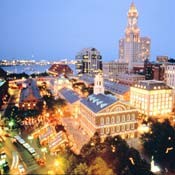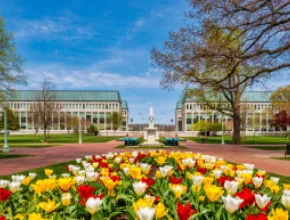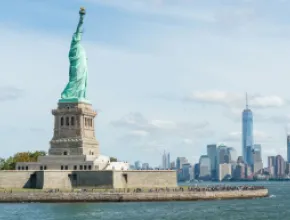Take a bow, Boston, and throw your cap high, Cambridge. Together, Beantown and its collegiate counterpart across the Charles River were named the top U.S. destination for international association meetings in 2006 by the venerable International Congress and Convention Association.
Credit goes to a sustained joint sales and marketing initiative targeting groups abroad, but that’s only part of Greater Boston’s story these days.
Increased leisure advertising and strong convention demand lifted Boston’s 2006 room night total and stimulated pre- and post-event travel in the area. Lodging supply is growing, too, with several new four- and five-star properties opening over the next three years.
Of course, this sort of growth data is generally not top of mind for travelers, but there is no missing the visible changes throughout the “Hub.”
There’s the wondrous harp-like Zakim Bunker Hill Bridge and the Central Artery’s under-city roadway network. There are sleek designer hotels like downtown’s Nine Zero, while Logan International Airport’s $4.4 billion modernization is complete, and the long-blighted “Southie” neighborhood, home to the triumphant Boston Convention and Exhibition Center, has another instant classic in the Institute of Contemporary Art’s new home.
The evidence of Boston’s transformation into a hot-wired global meeting place is everywhere.
“With comprehensive infrastructure upgrades and greatly enriched cultural and leisure offerings, we are now readily accessible to all our key markets and effectively equipped for any event,” says Beth Stehley, vice president, sales and convention services for the Greater Boston CVB.
An American Treasure
What can planners and delegates expect in America’s historic waterfront “Walking City,” known also as the “Athens of America” for its educational and research prowess? Like all great cities, Boston is found in its local treasures.
The North End is one of America’s most authentic and rewarding Italian neighborhoods.
Beacon Hill—the only surviving hill of three from the colony named “Trimount” in 1630 by English colonists who then renamed the city Boston after their hometown in Lincolnshire—is one square mile of cobblestone, gas-lit history, fronted by Boston Common. America’s oldest park, dating to 1634, the Common and Boston Public Garden form the northern end of the Olmstead-designed “Emerald Necklace” green belt encircling the city.
The adjacent Back Bay area features 19th century Revival and Victorian homes and superior shopping on Newbury and Boylston Streets at one end, with stately Copley Square and skyscrapers at the other. The 285-room Colonnade, home to 15 function rooms, the acclaimed Brasserie JO restaurant and Boston’s only rooftop pool, typifies Back Bay’s luxury hotels.
The landmark South End district, North America’s largest surviving Victorian neighborhood, features classic bow-front residences and global cuisine along Tremont Street.
For a sweeping perspective, head for the Skywalk Observatory on the 50th floor of the Prudential Tower. In addition to 50-mile views, the Skywalk accommodates private functions for 500 people, with the landmark Top of the Hub restaurant and bar two floors above another classic event venue.
Highly cultured Boston is home to ornate theaters such as the Boston Opera House and the Orpheum, along with world-renowned performing arts groups such as the famed Boston Pops.
The Museum of Fine Arts, the Science Museum and the Isabella Stewart Gardner Museum are must-sees, and the city’s prominence in the American Revolution is memorialized by historic sites along the Freedom Trail, marked by a red line and imbedded red bricks.
South Boston’s revival was assured three years ago with the opening of the visionary steel-and-glass Boston Convention and Exhibition Center (BCEC). Advertised as the world’s “most user-friendly convention center,” the mammoth facility features eight registration areas, universal Wi-Fi and cell coverage, and well-conceived flow ergonomics.
As the BCEC’s predecessor and now counterpart, the 175,000-square-foot Hynes Convention Center still holds its own as a choice venue. Conferees can also count on spectacular skyline and waterfront views at Seaport, which comprises the Seaport World Trade Center and the Seaport Hotel, while Bayside Expo is another premier group facility and hotel complex.
“We had 29 citywide conventions in 2006, and 28 are booked for this year,” Stehley says.
In fact, Boston just hosted 21,000 delegates for the BIO International Conference—clear evidence, as Stehley notes, “that Boston is in a new category.”
With 20,000 hotel rooms within 15 minutes of the city’s primary convention venues, delegates are close to all the attractions, and planners can eliminate costly transportation logistics. By January 2009, the projected number of guest rooms will be almost 21,500, part of an area-wide 30,242 rooms in more than 130 properties.
Last year, two major properties debuted: the Westin Boston Waterfront, which is attached to the BCEC; and the InterContinental Boston, located in the Financial District.
Several new properties are also scheduled to come on-line this year, including the Liberty Hotel in Beacon Hill, opening this summer; the waterfront Regent Hotel at Battery Wharf, debuting in November; and the Renaissance Boston Waterfront Hotel in South Boston, premiering in December.
Additionally, Mandarin Oriental Boston, the luxury hotel company’s first New England property, is slated to open in mid-2008 in Back Bay.
The newcomers are fortifying the city’s existing lineup of meetings-ready options, such as the so-called “Back Bay Six,” including the Fairmont Copley Plaza, Boston Park Plaza and Westin Copley Place, and the “Waterfront Six,” including the Hyatt Harborside, Hilton Boston Logan Airport and Boston Marriott Long Wharf.
Meanwhile, Boston’s current shining star on the attractions stage is the new home of the circa-1936 Institute of Contemporary Art. Steps from the BCEC and Boston’s first new museum building in a century, this visionary masterpiece, with its dramatic cantilevered upper floor, sends the clearest signal yet of a new age for the South Boston waterfront. The museum is selective—no weddings, please—but for approved events, the spaces, from the lobby’s towering glass walls to the intimate Water Cafe and outdoor patio, are meetings magic.
“Our future,” Stehely says, “is here today.”
Cambridge
The best joke in the comedy classic This Is Spinal Tap states, “Boston isn’t a big college town,” which is laughable due to the region’s multitude of colleges and universities.
Two powerhouses—Harvard and Massachusetts Institute of Technology (MIT)—are in the heart of Cambridge, the “Left Bank of the Charles.” International community and (counter) cultural center, Cambridge is Boston’s edgier, more artful side, with a universe of art, books, dining, and entertainment around Harvard, Inman, Porter, Central, and Kendall squares.
There’s also a terrific cluster of hotels, with the seven properties of the “Cambridge Conference Collection” providing nearly 3,500 rooms and 102,000 square feet of meeting space.
Groups can plug into the 196-room, high-tech Hotel@MIT, with vintage robots in the lobby and beautiful event space on the roof; take in the spectacular city views from the 400-room riverside Royal Sonesta; or get funky at the 236-room boutique Hotel Marlowe, with its richly hued decor and gourmet Bambara restaurant.
For a window on the fascinating world of MIT, planners can book a cocktail party or other event at the MIT Museum, where guests mingle among artificially intelligent machines, 3-D holograms and other creations from MIT’s world-renowned labs.
Farther east in the town of Wellesley, a top group retreat is Babson Executive Conference Center, set on the quiet, wooded campus of Babson College.
North of Boston
Between Boston and New Hampshire lies Essex County, or the North of Boston region, named after a 1914 poetry book by Robert Frost.
The area’s New England quintessence is Hollywood-ready, with Gloucester, America’s oldest seaport, providing the setting for the film The Perfect Storm.
Settled in 1630, Ipswich boasts 58 houses of pre-1724 vintage, Marblehead is the birthplace of the U.S. Navy and the U.S. Coast Guard, and Essex is an antiquers paradise.
There’s “a story in every mile” of the region’s lengthy shoreline, featuring classic venues such as Glen Magna Farms, a colonial revival mansion set on an 11-acre country estate.
This May, the area welcomes the new Cruiseport Gloucester, a cruise ship terminal with an ultra-chic, glass-walled function room that opens onto a wraparound balcony overlooking the harbor.
Among the region’s best property options for groups are the Essex Conference Center and Retreat in Cape Ann, with three meeting rooms and a facilitated ropes course; the Atlantic-facing Richard E. Wylie Conference and Education Center (formerly the Conference Center at Water’s Edge), an IACC-certified facility in Beverly with 22,000 square feet of function space; and the Marriott Peabody and Holiday Inn Hotel and Suites Boston Peabody.
The Witch Museum in Salem is good for a spooky look back at the infamous trials of 1692.
The history is even more dramatic in the Greater Merrimack Valley region, 30 minutes northwest of Boston on a good traffic day. In 1775, Lexington saw the midnight ride of Paul Revere, while Concord experienced the “shot heard ’round the world” that started the Revolutionary War.
There is no fighting for space today, though. The area has 4,000 hotel rooms, more than 230,000 square feet of flexible meeting space and generous exhibition space at the Tsongas Arena or historic Lowell Memorial Auditorium.
For More Info
Cambridge Office for Tourism 617.441.2884
www.cambridge-usa.org
Greater Boston CVB 617.536.4100
www.bostonusa.com
Greater Merrimack Valley CVB 978.459.6150
www.merrimackvalley.org
North of Boston CVB 978.977.7760
www.northofboston.org







